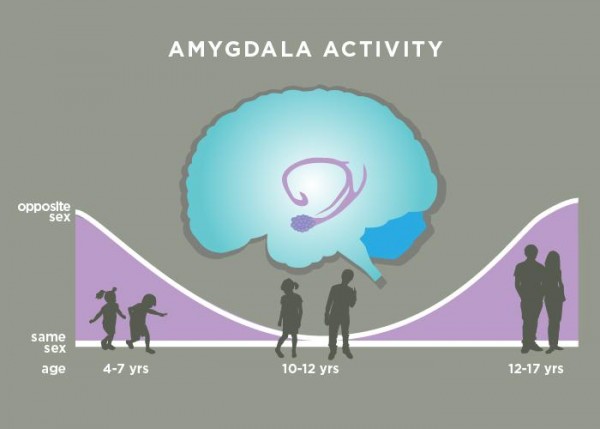Study: Amygdala encodes 'cooties' and 'crushes' in the developing brain

Scientists have found a signal in the brain that reflects young children's aversion to members of the opposite sex (the "cooties" effect) and also their growing interest in opposite-sex peers as they enter puberty. These two responses to members of the opposite sex are encoded in the amygdala, the researchers report.
The findings, reported in the Journal of Cognitive Neuroscience, challenge traditional notions about the role of the amygdala, the researchers say.
The team evaluated 93 children's attitudes toward same-sex and opposite-sex peers. Using functional MRI, which tracks how oxygenated blood flows in the brain, the researchers also analyzed brain activity in 52 children.
The amygdala was once thought of as a "threat detector," said University of Illinois psychology and Beckman Institute professor Eva Telzer, who led the new analysis. "But increasing evidence indicates that it is activated whenever someone detects something meaningful in the environment," she said. "It is a significance detector."
The finding that very young children are paying close attention to gender is not a surprise, Telzer said.
"We know that there are developmental changes in terms of the significance of gender boundaries in young kids," Telzer said. "We also know about the whole 'cooties' phenomenon," where young children develop an aversion to opposite-sex peers and act as if members of the opposite sex could, if they got too close, contaminate them with a dreadful infestation. Children at this age also tend to strongly prefer the company of their same-sex peers, she said.
This phenomenon was reflected in young children's evaluations of each other.
"Only the youngest children in our sample demonstrated a behavioral sex bias such that they rated same-sex peers as having more positive (and less negative) attributes than opposite-sex peers," the researchers wrote.
"And so we think the amygdala is signaling the significance of cooties at this developmental period," Telzer said.
The interest in opposite-sex peers tends to wane in later childhood, just before puberty, Telzer said. The researchers saw no difference in the amygdala's response to same-sex and opposite-sex faces in children between the ages of 10 and 12. (See graphic.)
But in puberty, children's interest in opposite-sex peers blooms anew. They may become infatuated with a member of the opposite sex, a phenomenon sometimes referred to as a "crush," Telzer said.
"When puberty hits, gender becomes more significant again, whether it's because your body is changing, or because of sexual attraction or you are becoming aware of more rigid sexual boundaries as you become more sexually mature," Telzer said. "The brain is responding very appropriately, in terms of what's changing developmentally."
Apr 09, 2015 07:46 PM EDT





